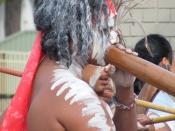Indigenous
Health
Contents:
QUESTION 1................... ......................................................Page 3
ANSWER ..............................................................................Page 3
Graph of Life Expectancy ..........................................................Page 4
Major Cause Of Sickness And Death ............................................Page 5
÷ Circulatory Diseases .............................................Page 5
÷ External Causes ...................................................Page 5
÷ Cancer ...............................................................Page 6
÷ Multiple causes of death ..........................................Page 6
QUESTION:
1. What Inequities exist in the health status of Indigenous People when compared to the non -Indigenous population?
ANSWER:
The life expectancy is the number of years a person can expect to live. Experimental methods were used by the Australian Bureau of Statistics to calculate life expectancies for indigenous people.
The life expectancy of indigenous males in NSW was estimated to be 56 years and indigenous females to be 63.6 years. For both males and females, the life expectancy of indigenous people was estimated to be about 20 years less than the non-Indigenous.
Experimental estimates of indigenous life expectancy in NSW are similar to other states and territories: estimates of the life expectancy of indigenous males vary from 55.3
years in South Australia to 56.2 years in Queensland, and for indigenous females vary from 61.2 years in South Australia to 63.5 years in Victoria.
Life expectancy
Indigenous population Males 56.3
Females 63.6
General population Males 76.4
Females 82.0
Aboriginal and Torres Strait Islander people are more likely to experience disability and reduced quality of life due to ill health, and to die at younger ages, than other Australians. The three leading causes of death for Indigenous people living in Queensland, South Australia, Western Australia and the Northern Territory were diseases of the circulatory system, deaths due to external causes (predominantly accidents, self harm and assault) and neoplasms (cancer). Deaths due to these causes accounted for 60% of all identified Indigenous deaths in these jurisdictions. These were also the leading causes of death among the...


